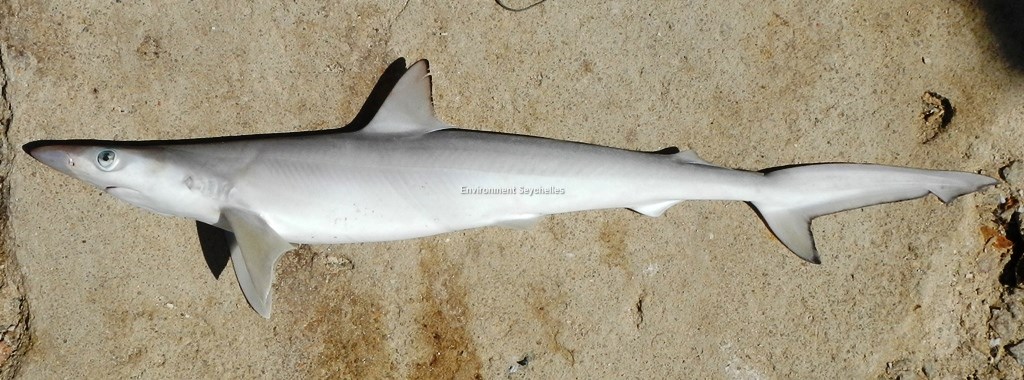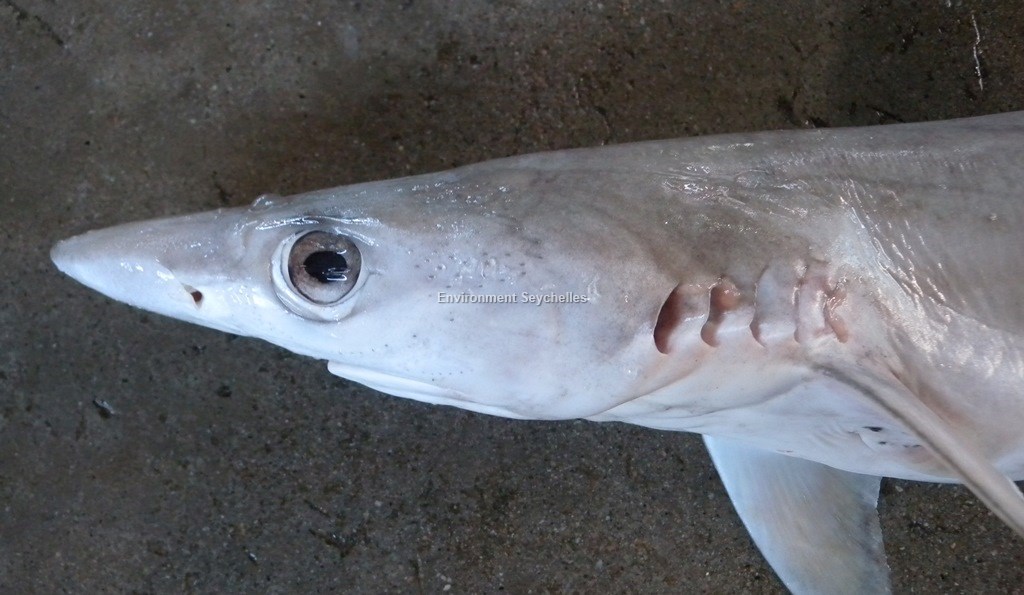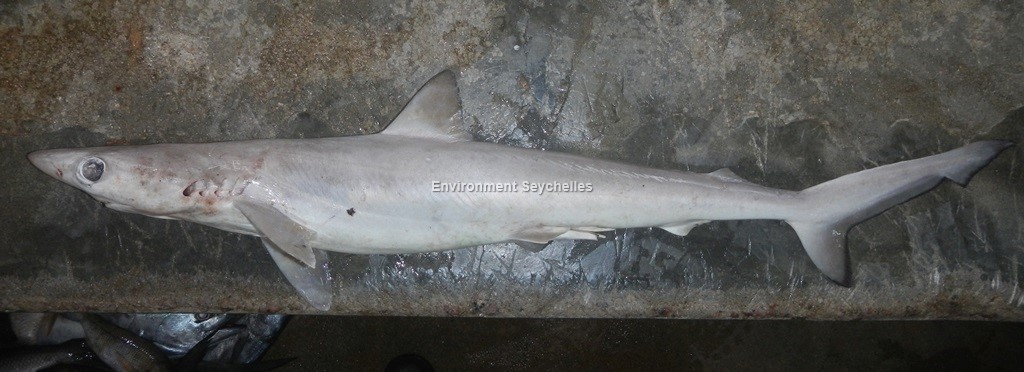Description:
Small, slender shark with a long narrow snout and very large eyes with posterior notches. Light grey to light grey-brown dorsally fading on the flanks to white ventrally. Fins and nose with pinkish tinge when alive or freshly caught and fins with translucent edges. D1 origin posterior to pectoral fin free edges and D2 posterior to anal fin.
Fins: D1 triangular with dark leading edge. Origin posterior to pectoral free tips. D2 low with long free rear tip. Origin posterior to anal fin. Interdorsal ridge absent or very slight. Pectorals falcate with pale or translucent trailing rear edge. Origin between third and fourth gill slit. Pelvic pale or translucent. Anal pale, anterior to and slightly larger than D2. Caudal pink colouration in freshly caught specimens otherwise pale, except for darker edges in some specimens and translucent trailing edge.
Head: Long narrow snout with very large eyes that exhibit characteristic posterior notches. Short gill slits. Anterior portion of snout exhibits darker shade of colouration (pinkish colour in life). Short upper and lower labial furrows. Triangular oblique teeth without serrations.
Size:
Born 40-45 cm TL. Mature: Male 62-66 cm TL, Female 75-80 cm TL, Maximum 99 cm TL.
Habitat and Ecology:
Insular and continental shelves in shallow water (depth 7-100 m, usually7-80 m). Eats small teleosts and invertebrates. Vivaparous 2-4 pups, usually 2, per litter and reproduce annually.
Fishery Status:
This species is not protected. It is however illegal to fish for sharks with nets (Fisheries Act, Reg 16.c). It is caught in the hand line fishery.
Notes:
L. macrorhinus was identified as the most widespread shark on the Mahé plateau during trawling experiments in the 1960s and 1970s. The species appears to have a distinct sexual segregation either in range or behaviour because it is rare to catch a female. L. macrorhinus is occasionally seen amongst the catch at the Victoria market.
There is strong anecdotal evidence to indicate a significant decline in the population of this species on the Mahé plateau.
References:
Ebert, D.A. et al. (2013). Sharks of the World – A fully illustrated guide. Wild Nature press ISBN 978-0-9573946-0-5
Fisheries Act 2014. Prohibition of net fishing of sharks, Reg. 16c of 1st August 1998. (Carried over from the 1986 Fisheries Act as per Fisheries Act 2014 para 79: Savings and Transitional provisions).
Froese, R. & D. Pauly. (Eds.) (2018). FishBase. https://www.fishbase.se/summary/Loxodon-macrorhinus (27/05/19).
Nevill, J.E.G. et al. (2015). An identification guide for the sharks of the Seychelles Artisanal Fishery.
Rigby, C.L. et al. (2021). Loxodon macrorhinus. The IUCN Red List 2021: https://dx.doi.org/10.2305/IUCN.UK.2021-2.RLTS.T41831A173435173.en. (09/02/24).
Simpfendorfer, C.A. & Stevens, J. (2003). Loxodon macrorhinus. The IUCN Red List 2003: e.T41831A10575744. http://dx.doi.org/10.2305/IUCN.UK.2003.RLTS.T41831A10575744.en. (27/05/19).
Citation:
Nevill, J.E.G. (2019). Loxodon macrorhinus, Sliteye shark. Seychelles Seatizens. www.seatizens.sc. https://seatizens.sc/species/loxodon-macrorhinus-muller-henle-1839/
(Updated 11/02/24).




Very good blog post.Really thank you!
Great share. If interested, visit my site on strategies: <a href="https://explore.org/livecams/brown-bears/brooks-falls-brown-bears-low“>Platincasinocom.De.
Really appreciate you sharing this post.Thanks Again. Cool.
I value the article.Much thanks again. Keep writing.
I cannot thank you enough for the blog post.Really thank you! Really Great.
Hey, thanks for the blog.Really thank you! Awesome.
Say, you got a nice post.Much thanks again. Much obliged.
Major thanks for the blog article. Fantastic.
Im grateful for the blog.Much thanks again. Want more.
A big thank you for your blog post.Thanks Again. Great.
Very informative blog article.Really looking forward to read more. Cool.
I really liked your blog article.Thanks Again. Keep writing.
Appreciate you sharing, great post. Keep writing.
I truly appreciate this blog.Really thank you!
Thanks-a-mundo for the blog.Much thanks again. Really Great.
I am so grateful for your post.Really looking forward to read more. Really Great.
Great blog article.Really thank you! Fantastic.
Thank you ever so for you post.Really looking forward to read more. Really Cool.
Very good article post.Thanks Again. Much obliged.
Looking forward to reading more. Great blog.Really thank you! Will read on…
Wow, great blog post. Fantastic.
Thanks again for the post.Really thank you! Cool.
Im thankful for the blog article.Really thank you! Awesome.
A big thank you for your blog article.Much thanks again. Keep writing.
I really like and appreciate your blog.Really thank you! Much obliged.
I think this is a real great blog article.Much thanks again.
Really appreciate you sharing this blog.Really looking forward to read more. Much obliged.
Looking forward to reading more. Great blog article.Thanks Again. Will read on…
Thanks a lot for the blog article.Thanks Again. Keep writing.